Thanks to Carl Farmer, Anne Reid and Stuart Dunlop for help with the id’s. Unfortunately many of the most interesting birds wouldn’t sit still for portraits - notably the male hen harrier and twites near Wideford Cairn, the Arctic skuas at Deerness and of course the ubiquitous bonxies (apparently an eighth of the world’s breeding pairs are on Hoy, which I can well believe).
| Great Woodrush Luzula sylvatica. Large areas of moorland on Hoy were covered in a monoculture of this plant, that normally grows in woods, suggesting that at one time there may have been at least a partial tree cover. It made walking hard work as one’s feet sank into the tussocks! |
 |
| Roseroot Sedum rosea. This was growing in abundance in the steep “Kame of Orkney” gully as well as on many sea cliffs. Apparently the roots are supposed to smell of roses! |
 |
| Roseroot variant Sedum rosea. In fact this is just the seeds rather than the flowers - makes it look quite different. |
 |
| Clifftop botany. Thrift Armeria maritima, birdsfoot trefoil Lotus corniculatus and sheep’s sorrel Rumex acetosella can be picked out in the turf. |
 |
| Squill Scilla verna. A real gem, which I’d never seen in the wild before - unfortunately it was over its best as Orkney had had an unusually warm, dry spring. Squills were by no means uncommon on short turf along the cliff-tops, usually where the soil was a little limy, or at least not-acid. |
 |
| Thrift Armeria maritima. The classic seaside plant: when thrift grows en masse like this it makes a fine show. |
 |
| Greater Sea Spurrey Spergularia media. An attractive little plant with fleshy leaves, found on the lower ledges of cliffs near Yesnaby. The flowers are larger and paler than the sea spurrey (S. marina) I have seen at Spurn on the Yorkshire coast. |
 |
| Sea Campion Silene uniflora. Another common seaside plant; this particular one was growing beside the Spergularia. |
 |
| Northern Marsh Orchid Dactylorhiza purpurella. Probably my favourite among the spotted / marsh orchids because of the wonderful colour. These orchids were common everywhere, including on the old broken concrete in front of the Scapa Flow Museum on Hoy. |
 |
| Creeping Willow Salix repens. The white “cotton wool” is on the seeds of a very small, ground-hugging willow, almost certainly a very prostrate form of S. repens. Although dwarf willow S. herbacea does grow on Orkney it has round leaves, not the small pointed ones that are visible in the foreground of this picture. |
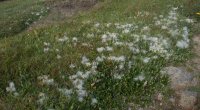 |
| Alpine Bearberry Arctostaphylos alpinus. This was quite a find, as it only grows in northern Scotland, almost always on high mountains and plateaux. This was on the moorland above the high cliffs of Hoy, probably at about 1200ft. The berries will ripen to black if the birds don’t eat them first. |
 |
| Butterwort Pinguicula vulgaris. An insectivorous plant of moorland bogs, where there is very little nutrient in the soil and so the plants have to supplement their diet with small flies. The leaves are sticky and roll in over any insect that lands and becomes trapped. The leaf rosettes always remind me of starfish. |
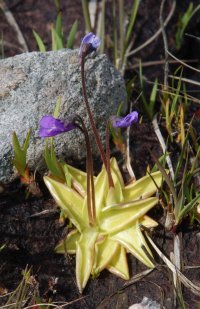 |
| Red Campion Silene dioica. A common enough species, but it grew particularly well along he coast. |
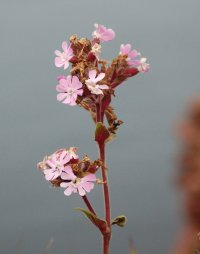 |
| Stone Bramble Rubus saxatilis. A rather dainty small cousin of bramble without the prickles, with flowers whose petals stick up at right-angles to the sepals. The fruit is red like a few-seeded raspberry but without the sweet juice - definitely one for the birds. Much commoner in Scotland than England. |
 |
| Emperor Moth Caterpillar Saturnia pavonia. This is a fairly young one - later on they show less black. |
 |
| Fulmars Fulmarus glacialis. Britain’s answer to the albatross.... |
 |
| Long-leaved (Great) Sundew Drosera anglica. This was a first for me - about a dozen plants were growing in just one patch alongside the track to the Old Man of Hoy, and we never saw it anywhere else. It wasn’t as much bigger than common sundew (D. rotundifolia) as I would have expected from the books. The two were growing more or less together. |
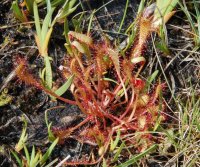 |
| Melancholy Thistle Cirsium heterophyllum. Another new plant, growing amongst the sand dunes at Sandwood Bay. We were a little early - as you can see it was still in bud. |
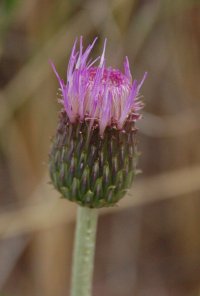 |
| Scottish Primrose Primula scotica. A lovely little purple primrose, endemic to northern Scotland and the Isles, but sadly it had finished flowering early after the hot spring (it has a second go in August). Oh, well, at least I can say I’ve seen it growing wild, at Yesnaby. |
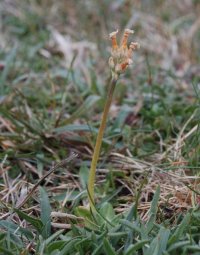 |
| Lichen Ramalina sp.. A rather nice specimen of lichen growing on the footings of one of the Viking longhouses at Birsay. Sea Ivory Ramalina siliquosa agg.. |
 |
| Razorbills Alca torda. One of the more picturesque seabirds. |
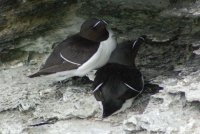 |
| Graculus and friend. Graculus, the great green bird who brought the bone portrait of Nooka, daughter of Nan, to Noggin, sailed with him beyond the black ice at the edge of the world and remained as his guide and counsellor through the many strange adventures that were to follow. Phalacrocorax aristotelis |
 |
| Peregrine Falco peregrinus. We saw at least three pairs of peregrines on Hoy (usually easy to spot because they were calling loudly to each other). This one’s mate (or possibly youngster) was over the cliffs to the right. We saw others further along the cliffs, and also two on the crags above the Dwarfie Stane. |
 |
| Clifftop flora. Including squills in the foreground and thrift in the middle, with a wonderful growth of “hairy” lichen on the rocks (probably more Sea Ivory Ramalina siliquosa agg.). |
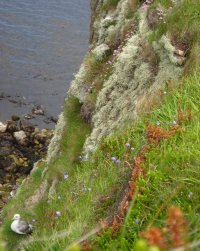 |























